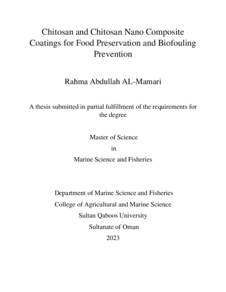Document
Chitosan and chitosan nano composite coatings for food preservation and biofouling prevention.
Other titles
عوازل مركبة من الشيتوزان والشيتوزان النانوية لحفظ الأغذية والوقاية من الحشف الحيوي
Publisher
Sultan Qaboos University.
Gregorian
2023
Language
English
Subject
English abstract
The preservation of perishable food products and the prevention of biofouling are important
challenges in meeting the nutritional demands of humans and ensuring the quality of fisheries
products. This study evaluated the effects of chitosan and chitosan composite coatings with
frankincense oil on microbial growth and strawberry quality. Additionally, the impact of
chitosan, chitosan-ZnO, and chitosan composite coatings with frankincense oil on micro-fouling
growth was examined through laboratory and microcosm experiments.
Strawberries were coated with different concentrations of chitosan (1% and 3%) with and
without frankincense oil, and various physical and chemical properties such as color, texture,
moisture content, pH, and total soluble solids were measured. Microbial analysis was also
conducted to assess the effectiveness of the coatings in reducing bacterial growth. The results
indicated that chitosan coatings did not significantly alter the physical and chemical properties of
the strawberries, but they resulted in lower bacterial counts compared to the control group.
Therefore, chitosan with frankincense oil could be considered a viable option for food
preservation purposes.
For antifouling applications, zinc oxide (ZnO) was incorporated into the chitosan and
frankincense oil coatings. Two sets of experiments were conducted: laboratory tests and
microcosm experiments. In the laboratory tests, both Gram-positive and Gram-negative bacteria
exhibited slower growth when exposed to light in the presence of the coatings. However, the
antifouling efficacy of the chitosan-ZnO composite coatings was comparable to that of the
chitosan coatings alone. In the microcosm experiment, the nanocomposite coating consisting of
2% chitosan and ZnO demonstrated the lowest bacterial counts. Therefore, it can be concluded
that the addition of frankincense oil and zinc oxide improved the antifouling properties of
chitosan in both laboratory and microcosm settings.
Member of
Resource URL
Arabic abstract
منع التأثيرات الخارجية البيولوجية والكيميائية والفيزيائية، باستخدام الطلاءات والتعبئة الصالحة للأكل لإطالة العمر الافتراضي للمنتجات الغذائية القابلة للتلف هي تحديات مهمة تساعد على تلبية متطلبات المغذيات اليومية لإلنسان. من ناحية أخرى، يعتبر الحشف الحيوي مصدر قلق خطير لقطاع مصايد الاسماك، لذلك من المهم تطوير حلول آمنة وفعالة لمنع الحشف. قيمت هذه الدراسة آثار الطلاء المركب بالكيتوزان والشيتوزان بزيت اللبان على نمو الميكروبات وجودة الفراولة. أي ًضا، لفحص تأثير الطلاءات المركبة بالكيتوزان ، والكيتوزان ZnO ، والشيتوزان بزيت اللبان على نمو القاذورات الدقيقة في التجارب المختبرية والوسطى. تم تحليل الفراولة المغطاة بتركيزات مختلفة من الكيتوزان )٪1 و ٪3( مع وبدون زيت اللبان. تم قياس الخواص الفيزيائية والكيميائية مثل اللون والملمس ومحتوى الرطوبة ودرجة الحموضة والمواد الصلبة الذائبة الكلية والتحليل الميكروبي. أظهرت النتائج أن طالء الشيتوزان لم يغير بشكل كبير الخواص الفيزيائية والكيميائية، وكانت البكتيريا أقل في طلاء الشيتوزان. وبالتالي، يمكن القول أن الشيتوزان مع زيت اللبان يمكن أن يكون خيا ًرا جيدًا في حفظ الطعام. مضاد للحشف، تم تضمين ZnO مع الشيتوزان وزيت اللبان. تم عمل تجربتين في معمل وتجربة خارجية. وأظهرت النتائج أنه في الاختبارات في المعمل، نمت كل من البكتيريا موجبة الجرام وسالبة الجرام بسرعة أقل عندما تعرض الطلاء للضوء. لكن الفعالية المضادة للحشف كانت مماثلة لطلاء الشيتوزان. في التجربة الخارجية، كان للمركب النانوي المكون من ٪2 من الكيتوزان و ZnO أقل عدد من البكتيريا. وبالتالي، يمكن الاستنتاج أنه في الاختبارات المعملية الخارجية، أدى زيت اللبان وأكسيد الزنك إلى تحسين قدرات الشيتوزان المضادة للحشف.
Category
Theses and Dissertations

